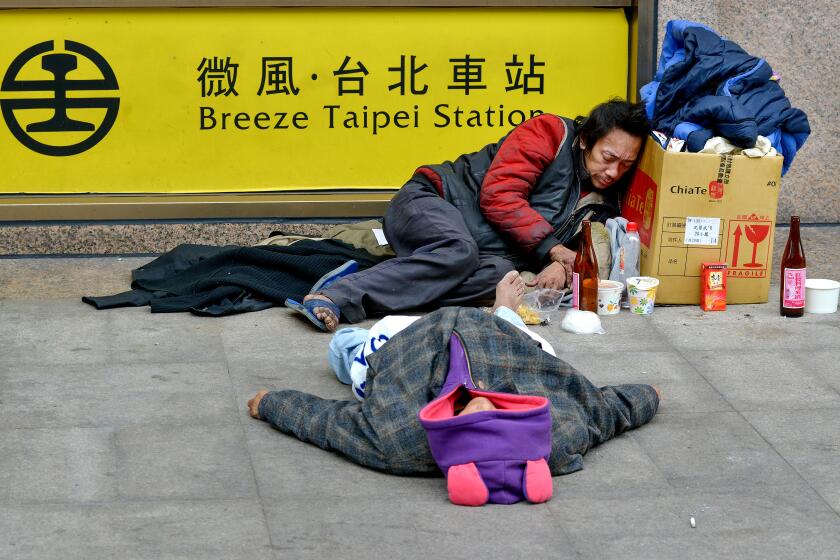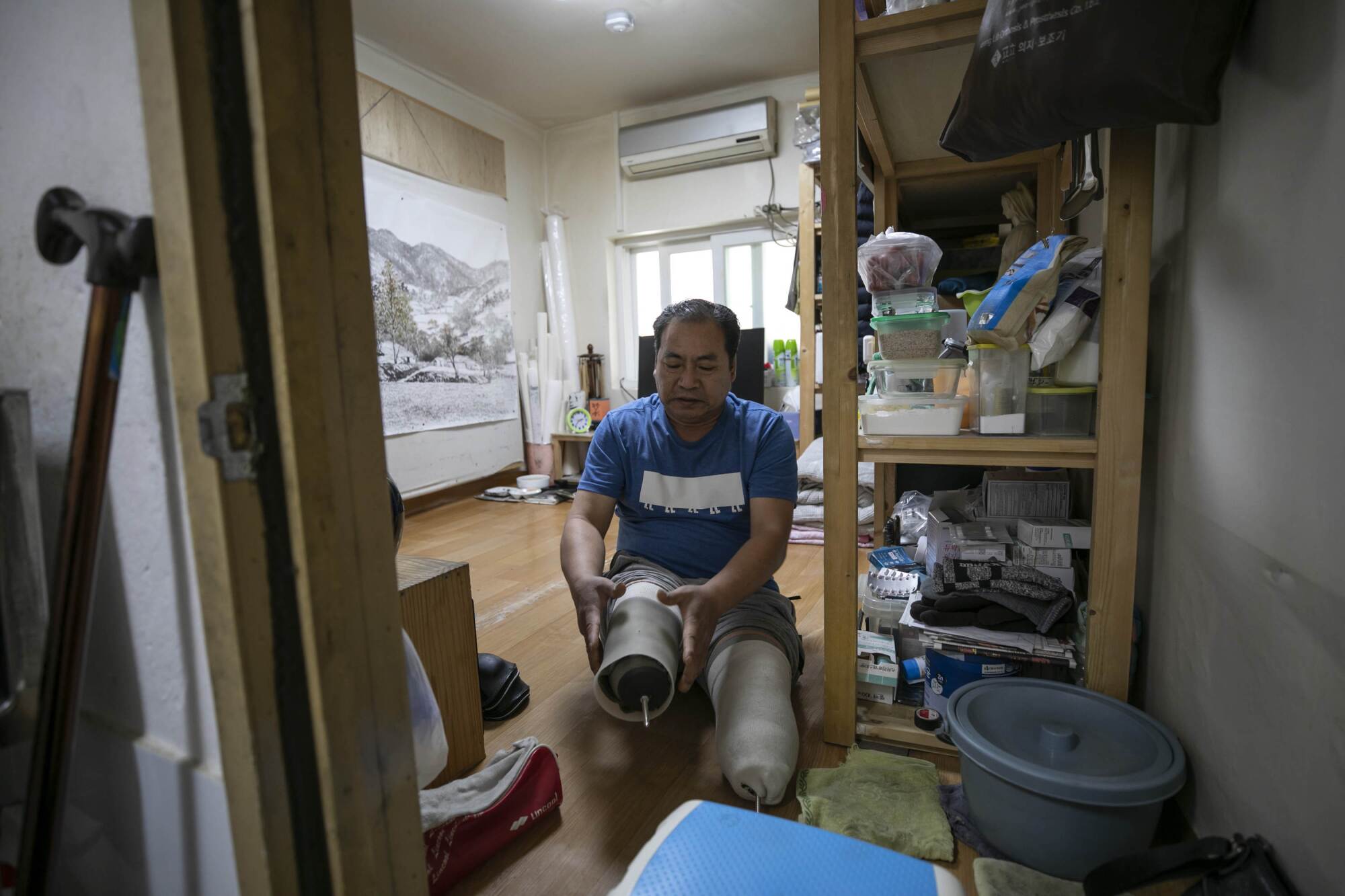
- Share via
SEOUL — Tucked in the back of a squat white building whose only other tenant is a soup kitchen, Yoon Yong-ju’s home is missing from the government property registry, but its placement and dimensions suggest that it was once a storage room.
Wondering how much longer he would be stuck here, Yoon, 60, surveyed the contents of the 35 or so square feet of space: wooden shelves holding a heap of medication, cardboard boxes stuffed with clothes, a refrigerator and a cluttered sideboard with a TV. In the middle was just enough space to lie down if Yoon, a double amputee, removed his prosthetic legs.
“The other residents call this a hotel room,” Yoon joked, pointing out the small luxuries that many in the neighborhood lack: an air conditioner, a large window, his own bathroom down the hall.
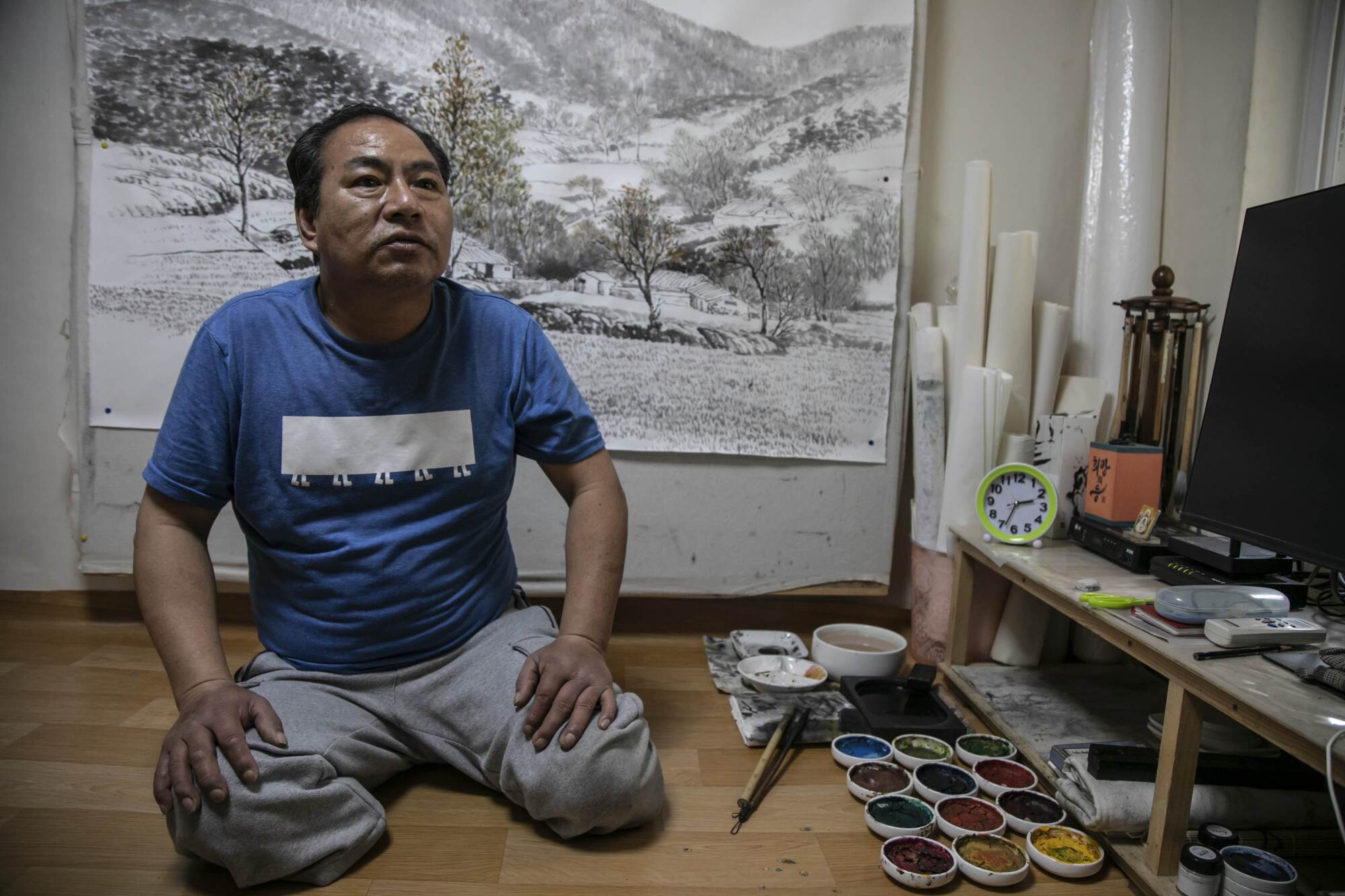
In a previous life, Yoon owned a small business and lived in a three-bedroom apartment with his wife and two children. But after losing it all more than 20 years ago in a series of catastrophes, he washed up here in Dongja-dong in central Seoul, where 1,000 or so illegally partitioned, single-person dwellings like his — called jjokbangs, or “piece rooms” — offer shelter to the most vulnerable of South Korea’s urban poor: the elderly, the disabled, the abandoned.
He had been trying to rebuild his life ever since and felt hopeful for the first time in years in February 2021, when the South Korean government announced an urban renewal plan that would tear down jjokbang neighborhoods to make way for public housing. In Dongja-dong, the plans included 1,250 new low-income rental units. Construction was due to break ground this year, after which tenants like Yoon would get more space, clean bathrooms and utilities that worked.
“We thought our wish was really coming true,” Yoon said.
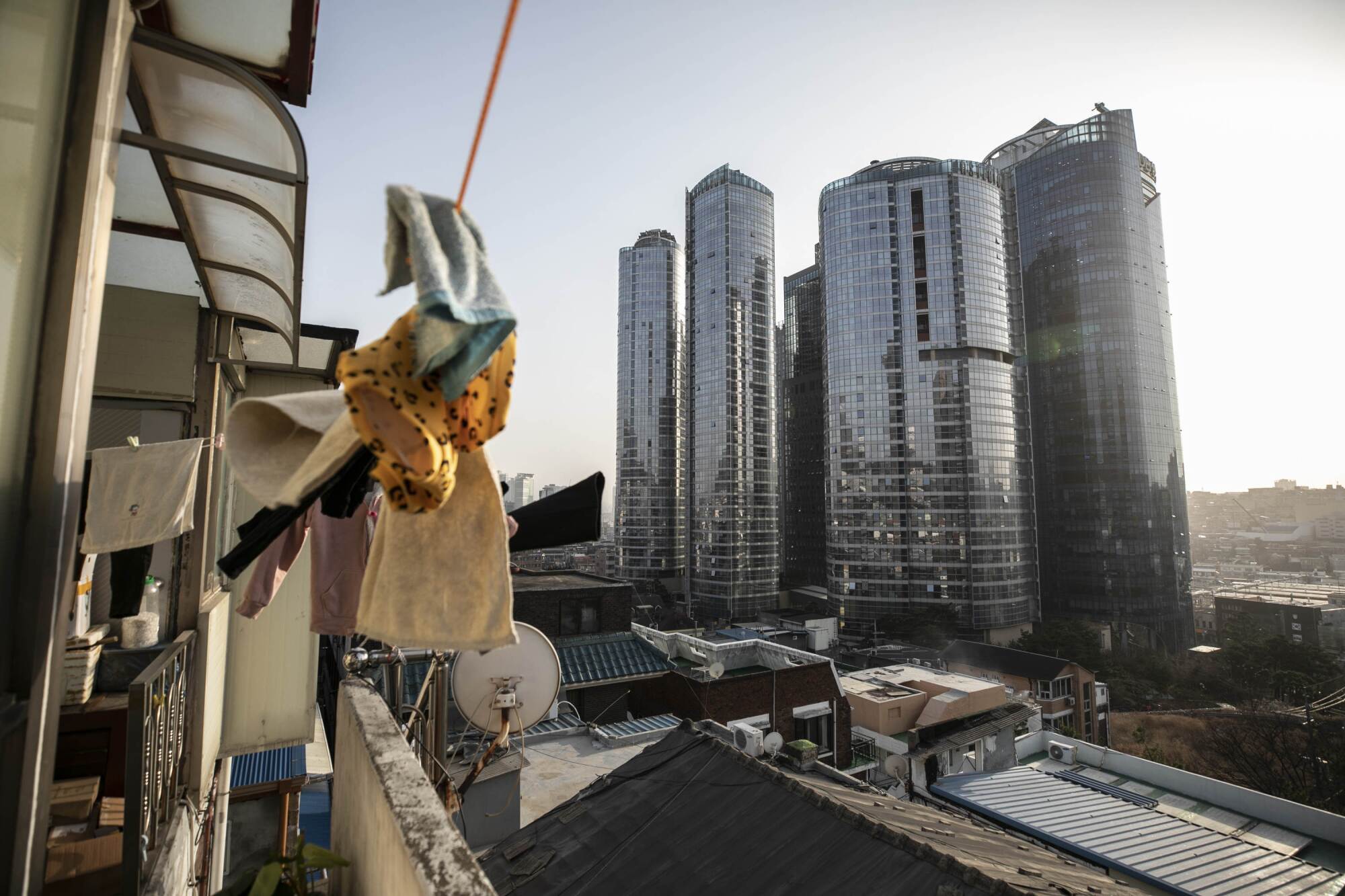
But shortly after the government announcement, the neighborhood’s property owners rallied against what they described as the unjust “confiscation” of their buildings and land, demanding a private-sector alternative that would likely reduce the number of low-income rentals to make room for more profitable ones.
‘You can’t tell whether it’s night or daytime,’ said a woman who lives in a semi-basement home featured in the Academy Award-winning ‘Parasite.’ ‘It’s a good place to dream.’
The group put up banners pledging “beautiful private development alongside jjokbang residents,” but Yoon feared it would result in mass displacement. Mired in disagreement, the plan has been stalled for two years.
It was a warm afternoon in late March, and Yoon maneuvered his electric wheelchair through the small park across from his house.
Despite the word “children” in the name of the park, its only inhabitants were the neighborhood’s elderly jjokbang residents.
“There aren’t any children in this neighborhood,” said Yoon, wheeling himself over to greet two men drinking soju out of paper cups and smoking cigarettes.
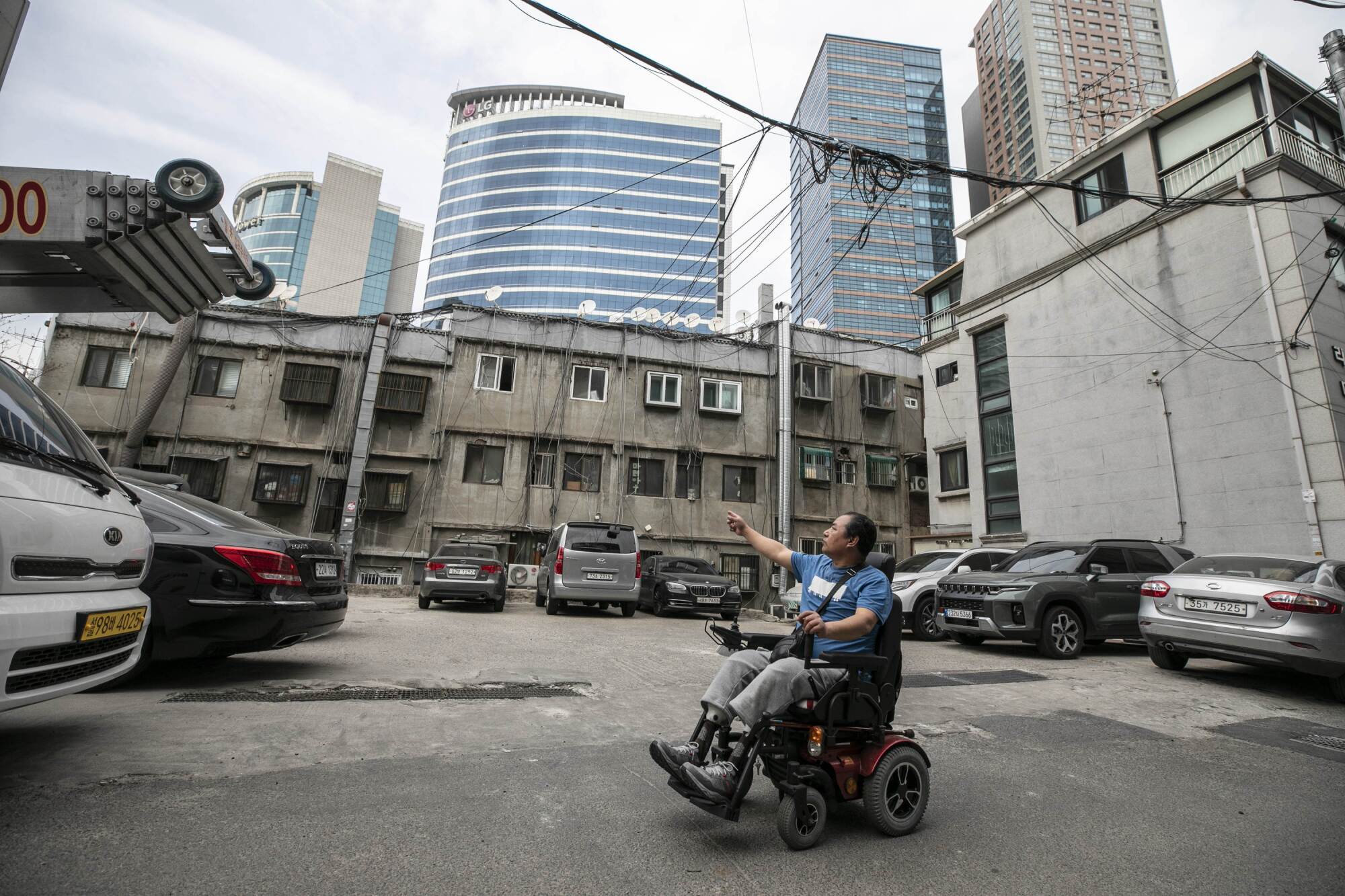
The degradation of the park is a common rallying cry among advocates for private development, who point to the urgent need to reverse what they call the “slumification” of the area. But to Yoon, the problems in the park — drinking, public urination and the occasional scuffle — speak to a need for better housing for all of the neighborhood’s jjokbang residents, who rely on it to escape the deadly summer heat in their rooms and to feel a little less alone.
“We come here because there is nowhere else for us to go,” Yoon said.
::
Seoul, a city of around 10 million, has an estimated 2,600 people on the streets or in shelters — far fewer than in Los Angeles or other major U.S. cities. But with just 166,000 or so low-income, government-owned apartments, an additional 320,000 live out of sight in substandard forms of housing, including jjokbangs.
They date back to the 1970s, an era of rapid industrialization when brothels and cheap inns catering to laborers and transients began making illegal modifications to squeeze in more lodgers. Following the 1997 Asian financial crisis, jjokbangs became a last refuge for the newly destitute.
For landlords, they are a lucrative investment that yields steady cash flow for very little overhead. Per square foot, jjokbangs command some of the most expensive rents in Seoul.
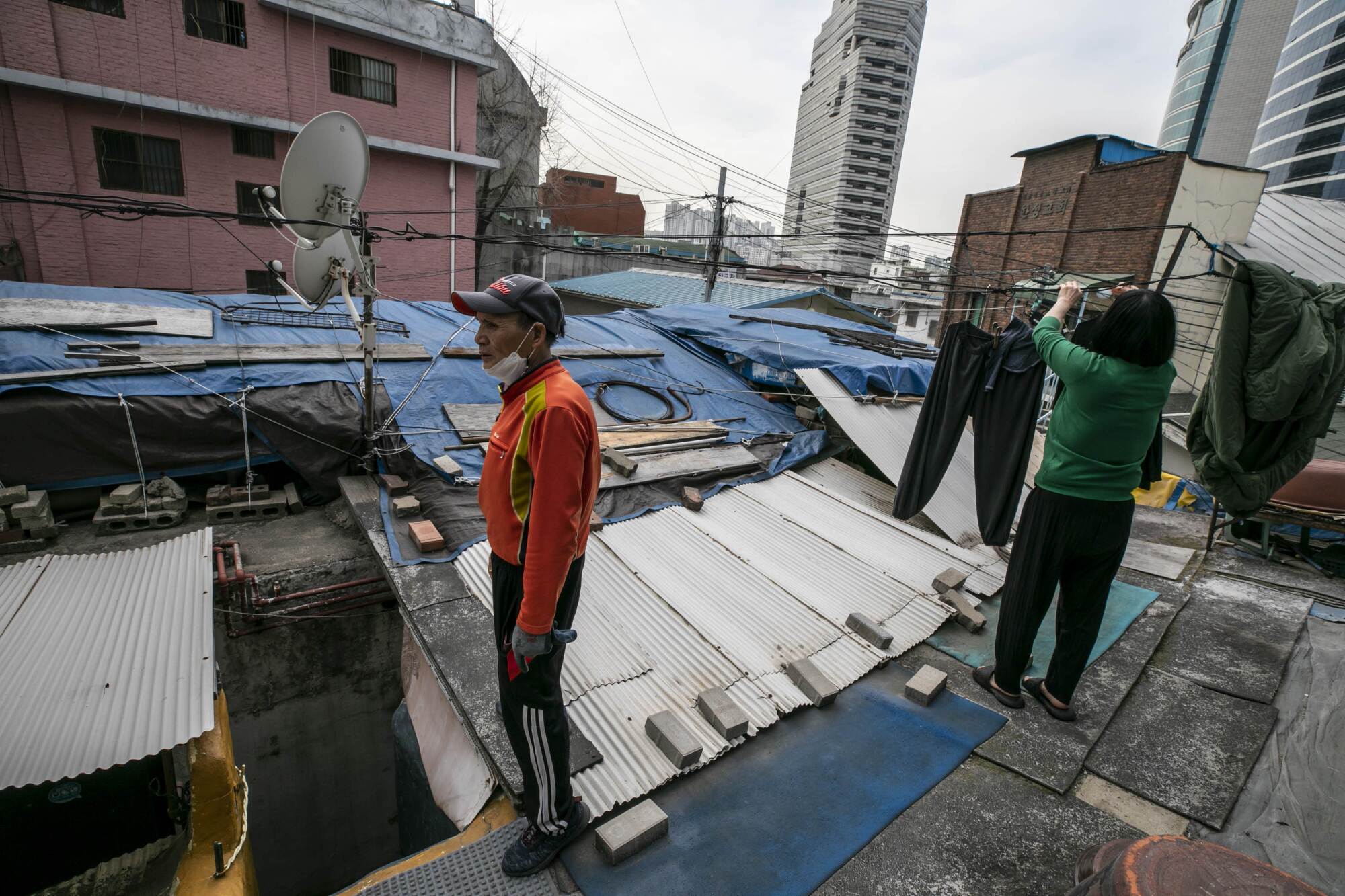
The living conditions fall well short of the standards for residential dwellings. But there is no punishment for breaking South Korea’s basic housing law, and without anything to replace them, jjokbangs have been allowed to exist as a necessary evil.
“They are used primarily by the outdoor homeless as a foothold to escape the streets,” said Lee Dong-hyun, a housing activist.
There are around 3,500 jjokbangs today, according to the Seoul Metropolitan Government.
“It is impossible to outlaw them until there are actual homes these people can live in,” said Ki Jae-Il, a city welfare official.
::
Yoon’s descent into homelessness was sudden.
In his early 30s, he was a painter living in the city of Jeonju, specializing in traditional Korean calligraphy landscapes, while making his living with a small business that rented out construction equipment. The financial crisis left him with a stack of unpaid invoices. The creditors came soon after.
“In an instant, I lost everything,” Yoon said.
He hopped from one flophouse to the next, sending what little money he could earn from construction jobs back to his wife and children. When he heard that the bank was about to seize the savings his wife had scraped together, he divorced her in order to sever his family from his debt.
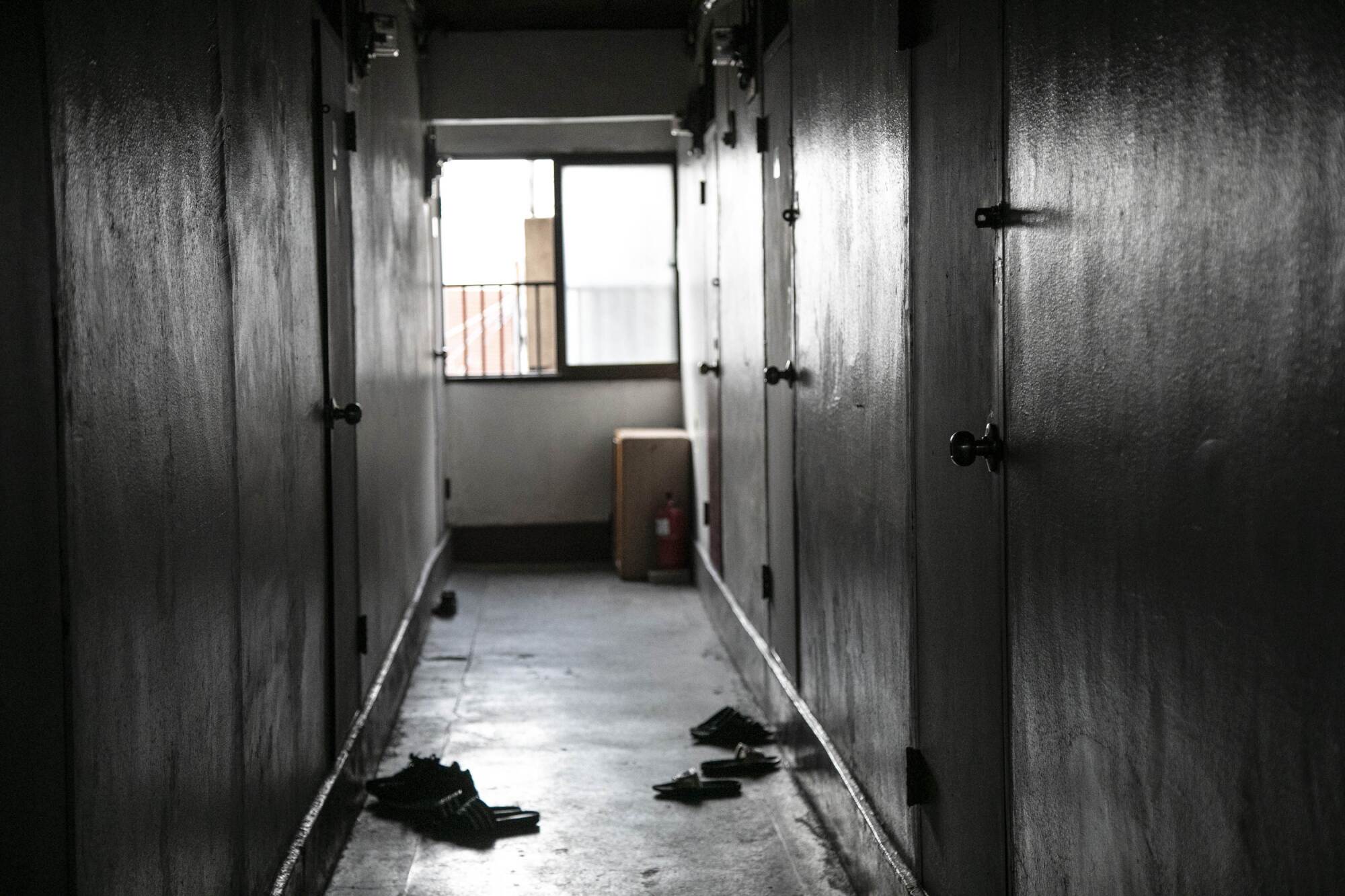
His health rapidly worsened in the period of homelessness that followed. A broken toe turned into a diabetic infection, which was difficult to treat on the streets.
“I could never stay in the hospital very long, so I’d get emergency care and then come back out, and then go back in when things got worse,” he said.
He eventually secured temporary government housing assistance and moved into a jjokbang for about $8 a night.
Residents shared a bathroom, where they bathed, rinsed rice or filled up drinking water from a faucet alongside the squat toilet. Heating and water would regularly fail, while fires would break out from the portable stoves people used to cook in their rooms. Cockroaches and mice ran rampant, and the stress from living in these conditions would frequently erupt in fights.
“Everybody is dealing with their own pain here,” Yoon said. “An environment where you can’t wash or rest properly worsens any mental illness and drains you, and then you lose your sense of self.”
Homelessness is a rare misfortune in Taiwan, but still a struggle. “I have nothing,” says one man. “I’m worried about starving.”
Gangrene in Yoon’s legs progressed to the point that they had to be amputated. Unable to use the squat toilet, he moved up the street to his current place, one of the few units with a sitting toilet.
He pays $206 in monthly rent. Add in utilities and debt repayments, and his welfare check of $633 leaves him $152 per month for food and other necessities.
Conditions in the neighborhood have only deteriorated since he arrived 18 years ago. In the extreme temperatures of summer or winter, the poorly insulated rooms become unbearably hot or cold. On sweltering nights, many tenants pack up their mats to sleep on the streets. But for the frail, heatwaves sometimes prove lethal.
Last winter, a water pipe burst in the tenement next to Yoon’s place, icing over the stairs and handrails and rendering the bathrooms unusable.
“City officials came out and broke up the ice and put temporary bathrooms in the park,” Yoon said. “The building owner wouldn’t do a thing.
“Landlords know just as well as tenants that people who end up here have no other alternatives,” he added. “All they say is, ‘If you don’t want to live here, leave.’”
::
On a brisk day in early March, Yoon and several other residents gathered for their weekly meeting at the Dongja-dong community center, where Yoon is president. A hand-drawn poster on the metal sliding door read: “Dongja-dong isn’t real estate. A neighborhood for housing rights, not profits.”
The door rattled open, and a visitor wandered in.
“Did you eat?” 62-year-old resident Kim Jeong-ho shouted — a common greeting in South Korea.
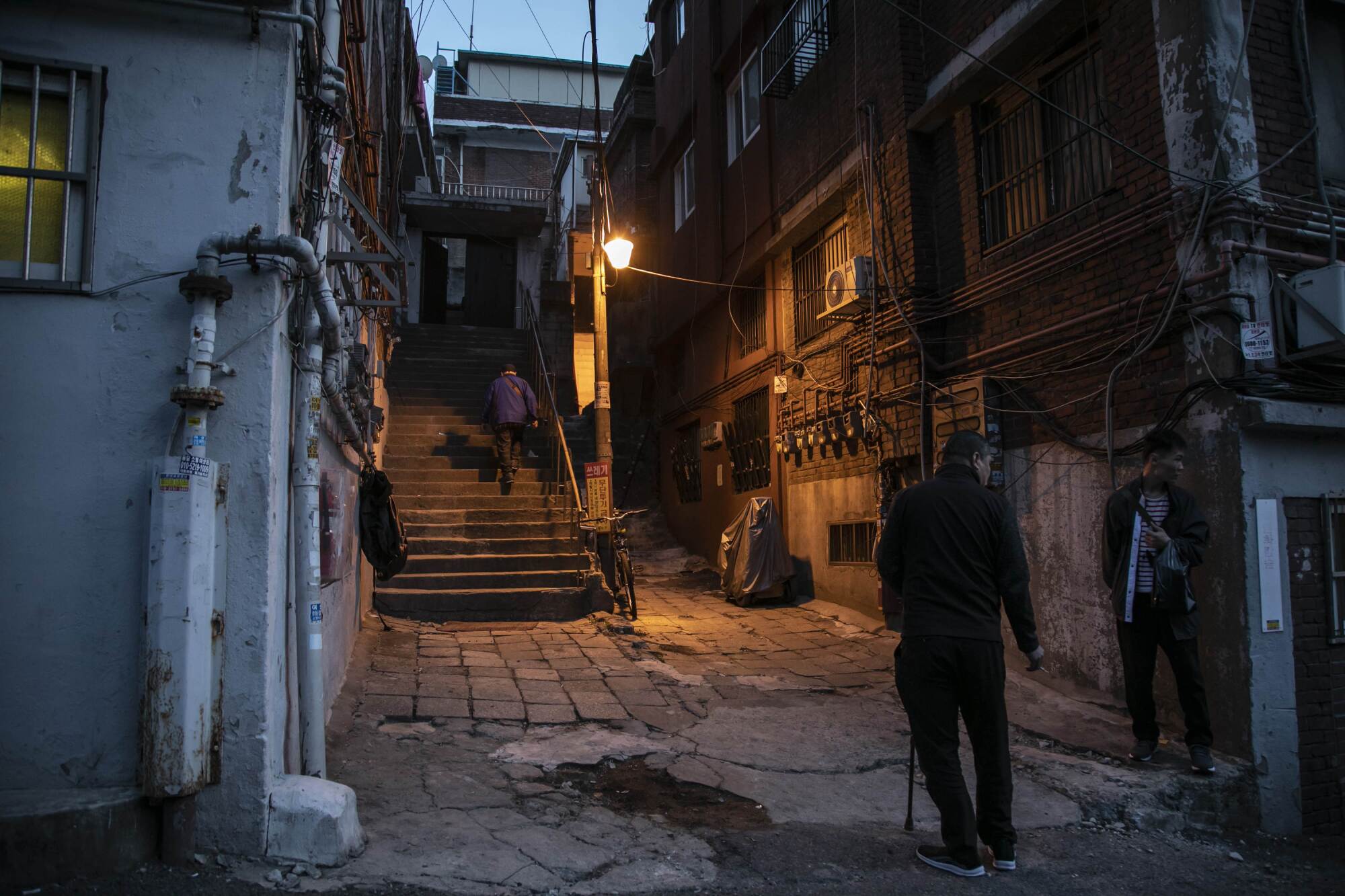
In addition to being a neighborhood hangout, where people trickle in and out to exchange hellos or pour themselves a cup of tea, the center uses outside donations and resident contributions to fund legal advice, rides to the hospital and gatherings on holidays.
When in need of quick cash for a sudden emergency, residents can turn to the center’s cooperative bank, which offers microloans at low interest rates.
Most of the neighborhood tenants here are solitary men in their 50s and 60s. All have stories not much different from Yoon’s.
“They come here because their families were destroyed, they lost their business or they became homeless on the streets,” said Kim, who runs the cooperative bank. More than half of local residents, many of whom are disabled, live off government welfare.
“The fact that you’re not allowed to work on welfare doesn’t make you whole, it makes you more of a cripple,” said Cha Jae-seol, a former construction worker who ended up in Dongja-dong after a back injury.
Yoon interrupted: “You shouldn’t say that. Receiving assistance means you can’t work in the first place.”
The topic of government assistance is a sore spot for Yoon. Under South Korean welfare law, direct kin bear a “duty of care” for their disabled elders — a holdover from an older era when traditional notions of filial duty still held true. In order to be approved for the maximum payouts, welfare applicants must prove that their children cannot or will not support them.
Several years ago, Yoon was notified that his payments were being revoked because his son, whom he hadn’t seen for years, had gotten a job after graduating from college.
“I didn’t give my kids anything, so I couldn’t bring myself to ask them to take care of me,” Yoon said.
After he threatened to kill himself, his payments were restarted.

Many tenants waste away from such deepening isolation, which often ends in godoksa, the Korean term for dying alone.
“A lot of people are lonely and suffering and tired, so they skip their medications and drink instead,” Kim Jeong-ho said.
Kim took off his cap to reveal a shaved head.
“I have stage-four lung cancer myself,” he said with a chuckle. “I might die the day after tomorrow.”
Families seldom come to claim the bodies.
::
The poor health of the neighborhood’s residents has made the public housing plan feel all the more urgent.
In late February, government officials held a forum with Dongja-dong’s property owners and jjokbang tenants to discuss the details of the redevelopment plan. But the proceedings quickly fell apart when the property owners began shouting over the officials and waving red protest signs.
Among those objecting to the plan was a retired lawyer named Shin Jong-soo, who has owned a two-story house in the neighborhood since 2004, among other homes in the city.
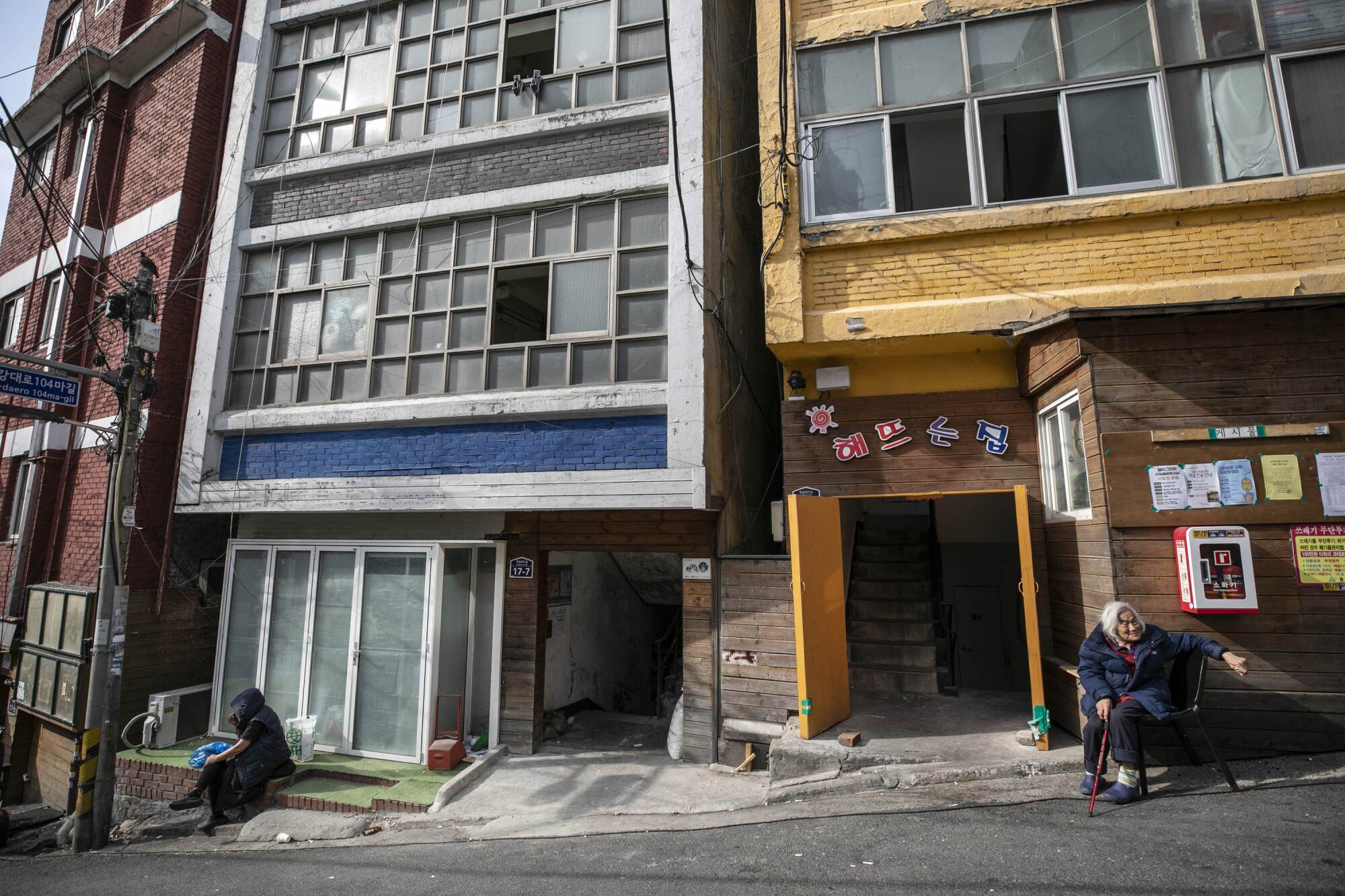
Even before the government announced its plan, Shin had hoped that Dongja-dong would someday be privately redeveloped. The neighborhood’s potential was obvious: It was five minutes from a subway station and a few blocks from the base of Mt. Namsan, Seoul’s iconic peak. Shin expected to receive one of the new apartments once his two-story house was razed.
That was the norm for such development schemes. But the authors of this plan had decided to take a stand against the sort of real estate speculation that strangles supply and drives up housing prices. In the spirit of supplying affordable homes to those who needed it most, the plan limited owners of multiple homes, like Shin, to compensation in land or cash.
An incensed Shin joined a property owners’ group led by a local real estate agent named Oh Jeong-ja. By the group’s estimate, 90% of the 350 or so property owners in the redevelopment area were subject to the same forced cash-out.
“The cash compensation won’t be close to the actual market value,” Oh said. “There are some speculators among the property owners; I’m not going to deny that. But do you know the pain of people who are living in an area that has become a slum?”
Shin said he is not a speculator and had intended to move his family into the two-story house until his three children saw the park.
“It was all homeless people covered in blankets, drinking soju and smoking cigarettes,” Shin said. “My kids said that they couldn’t stay there even for a single day.”
Instead, the family moved to an apartment his wife owned in an affluent neighborhood 15 minutes away and turned the two-story house into a guesthouse for travelers. The property has more than quadrupled in value since he bought it.
To win over aggrieved property owners like Shin, the government is pursuing legal changes that would allow them to be compensated in new apartments rather than cash.
Shin remains unconvinced. Redevelopment can produce only so many new homes, and the goal of 1,250 low-income units would leave too many poor people in the neighborhood, he argues, hindering the sort of upscale transformation he hopes to see.
“Take Asterium, for example,” Shin said, referring to the luxury high-rises across from Yoon’s house, where penthouses with marble paneling and panoramic views tower over the city. “Private development will be able to build something as good as that, if not better.”
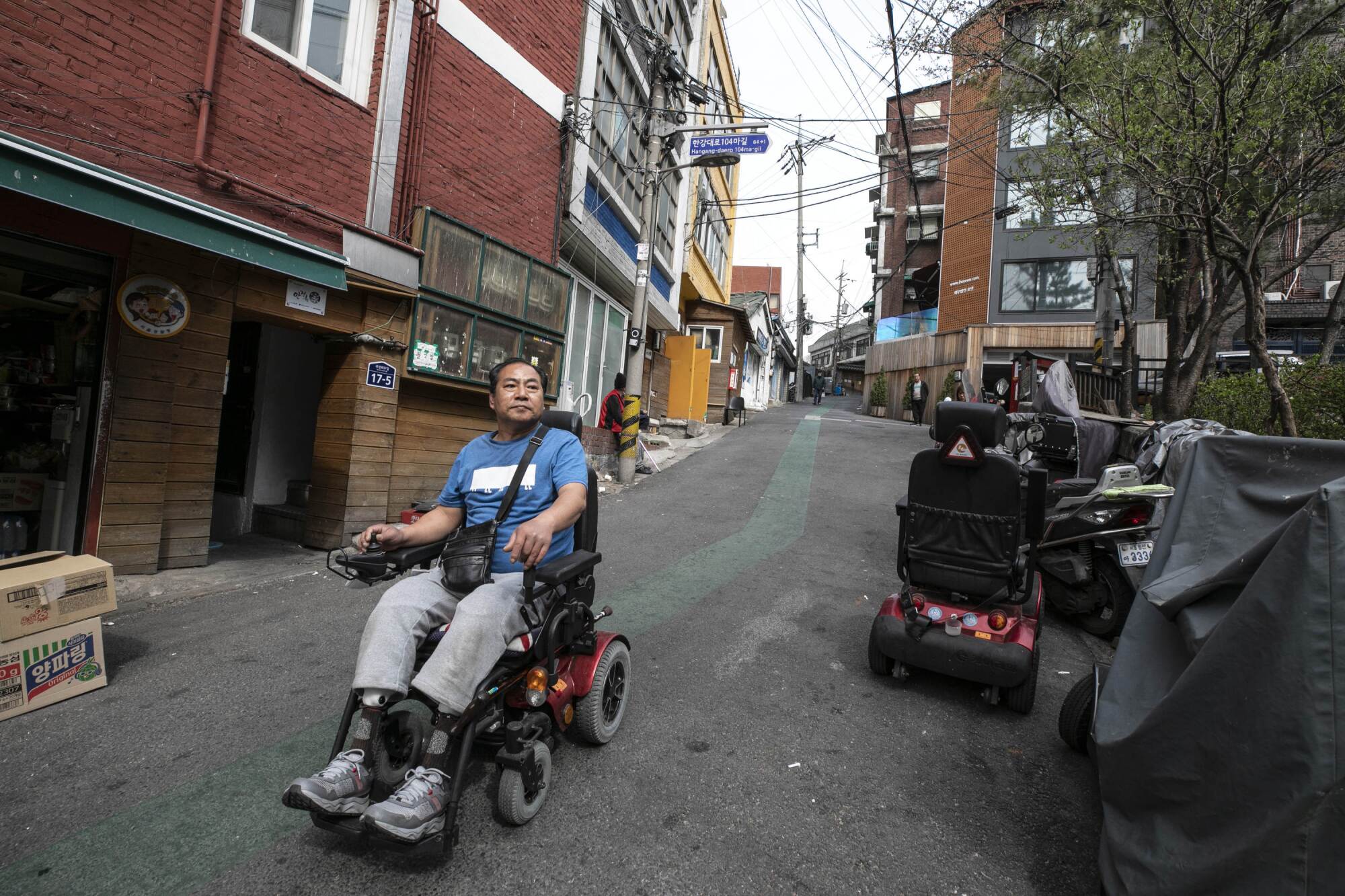
After the public meeting in February broke down, Yoon and his friends returned to their jjokbangs feeling dejected.
Time was not on their side: Some jjokbang tenants had died while waiting for good news to come, while others had given up hope. Having once been in the construction business himself, Yoon knew that the deadlock might drag on for years.
“There’s going to be a hard struggle ahead of us first,” he said.
More to Read
Sign up for Essential California
The most important California stories and recommendations in your inbox every morning.
You may occasionally receive promotional content from the Los Angeles Times.
